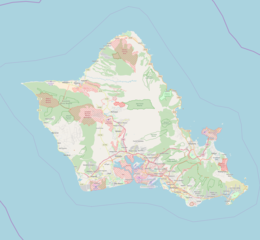 | |
  | |
| Geography | |
|---|---|
| Location | Oahu, Hawaii |
| Coordinates | 21°30′33″N 157°49′47″W / 21.5092°N 157.8297°W / 21.5092; -157.8297 |
| Area | 12.5 acres (5.1 ha) |
| Highest elevation | 206 ft (62.8 m) |
| Administration | |
| United States | |

Mokoliʻi (pronounced [mokoˈliʔi]), also known as Chinaman's Hat, is a basalt islet in Kāneʻohe Bay, Hawaii. Mokoliʻi is part of Kualoa Regional Park and located 1⁄3 mile (0.54 km) offshore of Kualoa Point, Oahu. The 12.5-acre (5.1 ha) islet was at one time part of a basaltic ridge on Oahu before marine erosion separated it.

Etymology
Mokoliʻi translates from Hawaiian as "little lizard." "Moko” is an older form of the word "mo’o" and means "lizard" or dragon-like creature; "li’i" means "small" or "tiny." According to the Pele epic in Hawaiian mythology, while the goddess Hiʻiaka was traveling to retrieve Pele's lover, Hi’iaka killed an evil giant lizard at Kuala. Part of its body fell into the bay and became Mokoli’i: the island is the tip of the tail sticking out of the water. The closest land on the main island is Hakipu’u, which bears the broken spine of the lizard, with "haki" meaning to break or broken and “Pu’u” meaning the hill or back.
The alternative name, Chinaman's Hat, derives from a comparison of its shape to the Asian conical hat. Of this alternative name, scholar kuʻualoha hoʻomanawanui has written: "It completely erases the Native perspective of the ‘āina as mo’o, a living entity that Hi’iaka—a female, no less—overpowers…Mokoli’i doesn’t exist in isolation as 'Chinaman's Hat' does." A resolution was introduced at the Hawaii State Legislature in 2007, requesting that the Hawaii Tourism Authority discourage the use of the name "Chinaman's Hat" in favor of Mokoliʻi, noting that the name "Chinaman's Hat" "has no historical or cultural significance" and "is offensive to many people of Chinese ancestry." The resolution did not pass the legislature.
Flora and fauna
Both wildlife and plants of Mokoliʻi have been affected by the presence of non-native species, in particular the black rat and yellow crazy ant. Although other species of birds previously nested there, the wedge-tailed shearwater is the only species of bird that nests on Mokoliʻi. Seventy-two species of plants have been identified, the majority of which are invasive non-native species. Native plants thrive in the coastal margins and include ahu awa (Cyperus javanicus), naupaka (Scaevola taccada), and ilima (Sida fallax). Invasive plants which dominate the slopes are Lantana camara, Spanish needles (Bidens alba var. radiata), and christmasberry. The island was designated as a critical habitat for Carter's panicgrass (Panicum fauriei var. carteri) by the U.S. Fish and Wildlife Service (USFWS) in 1983. In 2002, the USFWS initiated a program to eradicate rats from Mokoliʻi.
History
The U. S. Exploring Expedition of 1840 drew up a chart of Kaneohe Bay Harbor where it labeled Mokoliʻi as "Namu Island".
Mokoliʻi was under private ownership until the 1970s, when the City and County of Honolulu purchased it.
Access
Mokoliʻi is owned by the City and County of Honolulu and is protected by state and federal park regulations. It is open to the public from dawn to dusk. It can be accessed by kayak, boat, surfboard, or by swimming, or wading at low tide. There is also a 20-minute hike to the top of the island.
References
- ^ "Mokolii". Offshore Islet Restoration Committee. U.S. Fish and Wildlife Service Pacific Islands Office. Archived from the original on 5 September 2014. Retrieved 23 September 2013.
- ^ ho‘omanawanui, ku‘ualoha (2008). ""This Land Is Your Land, This Land Was My Land" : Kanaka Maoli versus Settler Representations of 'Āina in Contemporary Literature of Hawai'i". Asian settler colonialism : from local governance to the habits of everyday life in Hawai'i. Candace Fujikane, Jonathan Y. Okamura. Honolulu: University of Hawai'i Press. ISBN 978-1-4416-1961-7. OCLC 647928155.
- ^ Clark, John A. (November 1, 2004). Beaches of Oahu. A Latitude 20 Book (Revised ed.). University of Hawaii Press. pp. 79–80. ISBN 978-0824828929.
- ^ "Resolution to promote island by Hawaiian name fails to pass". Pacific Business Journal. May 6, 2007. Retrieved 2022-03-05.
- ^ Starr, Forest; Kim Starr (2006). "Oahu Offshore Islets Botanical Survey" (PDF). Hawaii State Department of Land and Natural Resources. pp. 49–50. Retrieved 25 September 2013.
- Joleen Aldous Gordon; Philip Helfrich (1970). "An Annotated Bibliography of Kaneohe Bay". Technical Report. 20. Hawaii Institute of Marine Biology. Retrieved 30 December 2024.
- "Chinaman's Hat - Kaaawa, Hawaii - Secluded Beach and Great Views on Mokolii Island".
- "Chinaman's Hat - Kaaawa, Hawaii - Secluded Beach and Great Views on Mokolii Island". citydata.com.
- Borders & Bucket Lists (2018-07-25). "The Adventures of Chinaman's Hat, Oahu, Hawaii". Borders & Bucket Lists. Retrieved 2019-02-02.
External links
- Mokolii Island on Google Maps As of 15 July 2011
- Mokolii Island on Yahoo! Maps As of 27 May 2007
| Islands, municipalities, and communities of Honolulu County, Hawaii, United States | |||||
|---|---|---|---|---|---|
| County seat: Honolulu | |||||
| CDPs |
|  | |||
| Other communities | |||||
| Government |
| ||||